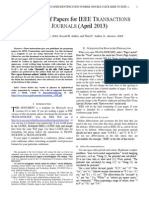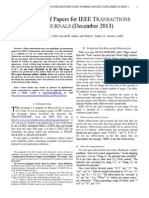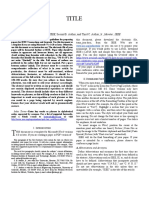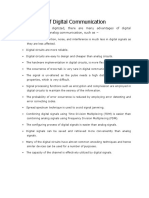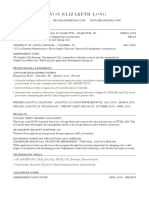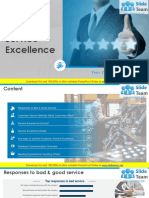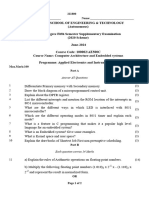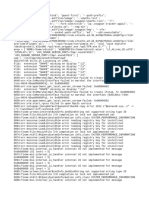Access Template
Access Template
Uploaded by
Icshan Afandi AfandyCopyright:
Available Formats
Access Template
Access Template
Uploaded by
Icshan Afandi AfandyOriginal Title
Copyright
Available Formats
Share this document
Did you find this document useful?
Is this content inappropriate?
Copyright:
Available Formats
Access Template
Access Template
Uploaded by
Icshan Afandi AfandyCopyright:
Available Formats
Date of publication xxxx 00, 0000, date of current version xxxx 00, 0000.
Digital Object Identifier 10.1109/ACCESS.2022.Doi Number
Preparation of Papers for IEEE Access
(February 2022)
First A. Author1, Fellow, IEEE, Second B. Author2, and Third C. Author, Jr.3, Member, IEEE
1
National Institute of Standards and Technology, Boulder, CO 80305 USA
2
Department of Physics, Colorado State University, Fort Collins, CO 80523 USA
3
Electrical Engineering Department, University of Colorado, Boulder, CO 80309 USA
Corresponding author: First A. Author (e-mail: author@ boulder.nist.gov).
This paragraph of the first footnote will contain support information, including sponsor and financial support acknowledgment. For example,
“This work was supported in part by the U.S. Department of Commerce under Grant BS123456.”
ABSTRACT These instructions give you guidelines for preparing papers for IEEE Access. Use this
document as a template if you are using Microsoft Word 6.0 or later. Otherwise, use this document as an
instruction set. The electronic file of your paper will be formatted further at IEEE. Paper titles should be
written in uppercase and lowercase letters, not all uppercase. Avoid writing long formulas with subscripts
in the title; short formulas that identify the elements are fine (e.g., “Nd–Fe–B”). Do not write “(Invited)” in
the title. Full names of authors are preferred in the author field, but are not required. Put a space between
authors’ initials. The abstract must be a concise yet comprehensive reflection of what is in your article. In
particular, the abstract must be self-contained, without abbreviations, footnotes, or references. It should be a
microcosm of the full article. The abstract must be between 150–250 words. Be sure that you adhere to
these limits; otherwise, you will need to edit your abstract accordingly. The abstract must be written as one
paragraph, and should not contain displayed mathematical equations or tabular material. The abstract
should include three or four different keywords or phrases, as this will help readers to find it. It is important
to avoid over-repetition of such phrases as this can result in a page being rejected by search engines. Ensure
that your abstract reads well and is grammatically correct.
INDEX TERMS Enter key words or phrases in alphabetical order, separated by commas. Using the IEEE
Thesaurus can help you find the best standardized keywords to fit your article. Use the thesaurus access request
form for free access to the IEEE Thesaurus https://www.ieee.org/publications/services/thesaurus.html
I. INTRODUCTION II. GUIDELINES FOR MANUSCRIPT
This document is a template for Microsoft Word versions PREPARATION
6.0 or later. If you are reading a paper or PDF version of
this document, please download the electronic file, Word
template, from the IEEE Author Center at When you open trans_jour.docx, select “Page Layout” from
http://ieeeauthorcenter.ieee.org/create-your-ieee-article/ the “View” menu in the menu bar (View | Page Layout),
use-authoring-tools-and-ieee-article-templates/ieee- (these instructions assume MS 6.0. Some versions may have
article-templates/ so you can use it to prepare your alternate ways to access the same functionalities noted here).
manuscript. If you would prefer to use LaTeX, download Then, type over sections of trans_jour.docx or cut and paste
IEEE’s LaTeX style and sample files from the same Web from another document and use markup styles. The pull-
page. You can also explore using the Overleaf editor at down style menu is at the left of the Formatting Toolbar at
https://www.overleaf.com/blog/278-how-to-use-overleaf- the top of your Word window (for example, the style at this
with-ieee-collabratec-your-quick-guide-to-getting- point in the document is “Text”). Highlight a section that you
started#.Vp6tpPkrKM9 want to designate with a certain style, and then select the
appropriate name on the style menu. The style will adjust
your fonts and line spacing. Do not change the font sizes or
VOLUME XX, 2017 1
line spacing to squeeze more text into a limited number of
pages. Use italics for emphasis; do not underline.
To insert images in Word, position the cursor at the Number equations consecutively with equation numbers in
insertion point and either use Insert | Picture | From File or parentheses flush with the right margin, as in (1). First use
copy the image to the Windows clipboard and then Edit | the equation editor to create the equation. Then select the
Paste Special | Picture (with “float over text” unchecked). “Equation” markup style. Press the tab key and write the
IEEE will do the final formatting of your paper. If your equation number in parentheses. To make your equations
paper is intended for a conference, please observe the more compact, you may use the solidus ( / ), the exp
conference page limits. function, or appropriate exponents. Use parentheses to avoid
ambiguities in denominators. Punctuate equations when they
A. ABBREVIATIONS AND ACRONYMS are part of a sentence, as in
Define abbreviations and acronyms the first time they are
E = mc2
used in the text, even after they have already been defined in
the abstract. Abbreviations such as IEEE, SI, ac, and dc do (1)
not have to be defined. Abbreviations that incorporate
periods should not have spaces: write “C.N.R.S.,” not “C. N. Be sure that the symbols in your equation have been
R. S.” Do not use abbreviations in the title unless they are defined before the equation appears or immediately
unavoidable (for example, “IEEE” in the title of this article). following. Italicize symbols (T might refer to temperature,
but T is the unit tesla). Refer to “(1),” not “Eq. (1)” or
B. OTHER RECOMMENDATIONS “equation (1),” except at the beginning of a sentence:
Use one space after periods and colons. Hyphenate complex “Equation (1) is ... .”
modifiers: “zero-field-cooled magnetization.” Avoid
dangling participles, such as, “Using (1), the potential was IV. UNITS
calculated.” [It is not clear who or what used (1).] Write Use either SI (MKS) or CGS as primary units. (SI units are
instead, “The potential was calculated by using (1),” or strongly encouraged.) English units may be used as
“Using (1), we calculated the potential.” secondary units (in parentheses). This applies to papers in
Use a zero before decimal points: “0.25,” not “.25.” Use data storage. For example, write “15 Gb/cm 2 (100 Gb/in2).”
“cm3,” not “cc.” Indicate sample dimensions as “0.1 cm × An exception is when English units are used as identifiers
0.2 cm,” not “0.1 × 0.2 cm2.” The abbreviation for “seconds” in trade, such as “3½-in disk drive.” Avoid combining SI
is “s,” not “sec.” Use “Wb/m2” or “webers per square meter,” and CGS units, such as current in amperes and magnetic
not “webers/m2.” When expressing a range of values, write field in oersteds. This often leads to confusion because
“7 to 9” or “7-9,” not “7~9.” equations do not balance dimensionally. If you must use
A parenthetical statement at the end of a sentence is mixed units, clearly state the units for each quantity in an
punctuated outside of the closing parenthesis (like this). (A equation.
parenthetical sentence is punctuated within the parentheses.) The SI unit for magnetic field strength H is A/m.
In American English, periods and commas are within However, if you wish to use units of T, either refer to
quotation marks, like “this period.” Other punctuation is magnetic flux density B or magnetic field strength
“outside”! Avoid contractions; for example, write “do not” symbolized as µ0H. Use the center dot to separate compound
instead of “don’t.” The serial comma is preferred: “A, B, and units, e.g., “A·m2.”
C” instead of “A, B and C.”
If you wish, you may write in the first person singular or V. SOME COMMON MISTAKES
plural and use the active voice (“I observed that ...” or “We The word “data” is plural, not singular. The subscript for the
observed that ...” instead of “It was observed that ...”). permeability of vacuum µ0 is zero, not a lowercase letter “o.”
Remember to check spelling. If your native language is not The term for residual magnetization is “remanence”; the
English, please get a native English-speaking colleague to adjective is “remanent”; do not write “remnance” or
carefully proofread your paper. “remnant.” Use the word “micrometer” instead of “micron.”
A graph within a graph is an “inset,” not an “insert.” The
III. MATH word “alternatively” is preferred to the word “alternately”
If you are using Word, use either the Microsoft Equation (unless you really mean something that alternates). Use the
Editor or the MathType add-on (http://www.mathtype.com) word “whereas” instead of “while” (unless you are referring
for equations in your paper (Insert | Object | Create New | to simultaneous events). Do not use the word “essentially” to
Microsoft Equation or MathType Equation). “Float over mean “approximately” or “effectively.” Do not use the word
text” should not be selected. “issue” as a euphemism for “problem.” When compositions
are not specified, separate chemical symbols by en-dashes;
C. EQUATIONS for example, “NiMn” indicates the intermetallic compound
VOLUME XX, 2017 1
Ni0.5Mn0.5 whereas “Ni–Mn” indicates an alloy of some “complement” and “compliment,” “discreet” and “discrete,”
composition NixMn1-x. “principal” (e.g., “principal investigator”) and “principle”
Be aware of the different meanings of the homophones
“affect” (usually a verb) and “effect” (usually a noun),
Data charts which are typically black and white, but
sometimes include color.
FIGURE 1. Magnetization as a function of applied field. Note
that “Fig.” is abbreviated. There is a period after the figure number,
followed by two spaces. It is good practice to explain the significance of
the figure in the caption.
(e.g., “principle of measurement”). Do not confuse “imply”
and “infer.”
Prefixes such as “non,” “sub,” “micro,” “multi,” and
“ultra” are not independent words; they should be joined to
the words they modify, usually without a hyphen. There is no
period after the “et” in the Latin abbreviation “et al.” (it is
also italicized). The abbreviation “i.e.,” means “that is,” and
the abbreviation “e.g.,” means “for example” (these
abbreviations are not italicized).
A general IEEE styleguide is available at
www.ieee.org/authortools.
VI. GUIDELINES FOR GRAPHICS PREPARATION
AND SUBMISSION
A. TYPES OF GRAPHICS
The following list outlines the different types of graphics
published in IEEE journals. They are categorized based on
their construction, and use of color / shades of gray:
1) COLOR/GRAYSCALE FIGURES
Figures that are meant to appear in color, or shades of
black/gray. Such figures may include photographs,
illustrations, multicolor graphs, and flowcharts.
2) LINE ART FIGURES
Figures that are composed of only black lines and shapes.
These figures should have no shades or half-tones of gray,
only black and white.
3) AUTHOR PHOTOS
Head and shoulders shots of authors that appear at the end of
our papers.
4) TABLES
VOLUME XX, 2017 1
TABLE I B. MULTIPART FIGURES
UNITS FOR MAGNETIC PROPERTIES
Figures compiled of more than one sub-figure presented side-
Conversion from Gaussian and
Symbol Quantity
CGS EMU to SI a
by-side, or stacked. If a multipart figure is made up of
magnetic flux 1 Mx 108 Wb = 108 V·s multiple figure types (one part is lineart, and another is
B magnetic flux density, 1 G 104 T = 104 Wb/m2 grayscale or color) the figure should meet the stricter
magnetic induction guidelines.
H magnetic field strength 1 Oe 103/(4) A/m
m magnetic moment 1 erg/G = 1 emu
103 A·m2 = 103 J/T C. FILE FORMATS FOR GRAPHICS
M magnetization 1 erg/(G·cm3) = 1 emu/cm3 Format and save your graphics using a suitable graphics
103 A/m processing program that will allow you to create the images
4M magnetization 1 G 103/(4) A/m
specific magnetization 1 erg/(G·g) = 1 emu/g 1
as PostScript (PS), Encapsulated PostScript (.EPS), Tagged
A·m2/kg Image File Format (.TIFF), Portable Document Format
j magnetic dipole 1 erg/G = 1 emu (.PDF), or Portable Network Graphics (.PNG) sizes them,
moment 4 1010 Wb·m and adjusts the resolution settings. If you created your source
J magnetic polarization 1 erg/(G·cm3) = 1 emu/cm3
4 104 T files in one of the following programs you will be able to
, susceptibility 1 4 submit the graphics without converting to a PS, EPS, TIFF,
mass susceptibility 1 cm3/g 4 103 m3/kg PDF, or PNG file: Microsoft Word, Microsoft PowerPoint,
permeability 1 4 107 H/m or Microsoft Excel. Though it is not required, it is strongly
= 4 107 Wb/(A·m)
relative permeability
recommended that these files be saved in PDF format rather
r r
w, W energy density 1 erg/cm3 101 J/m3 than DOC, XLS, or PPT. Doing so will protect your figures
N, D demagnetizing factor 1 1/(4) from common font and arrow stroke issues that occur when
Vertical lines are optional in tables. Statements that serve as captions
working on the files across multiple platforms. When
for the entire table do not need footnote letters. submitting your final paper, your graphics should all be
a
Gaussian units are the same as cg emu for magnetostatics; Mx = submitted individually in one of these formats along with the
maxwell, G = gauss, Oe = oersted; Wb = weber, V = volt, s = second, T =
manuscript.
tesla, m = meter, A = ampere, J = joule, kg = kilogram, H = henry.
D.
VOLUME XX, 2017 1
Author Name: Preparation of Papers for IEEE Access (February 2017)
E. SIZING OF GRAPHICS the fonts embedded, parts of the graphic may be distorted or
Most charts, graphs, and tables are one column wide (3.5 missing.
inches / 88 millimeters / 21 picas) or page wide (7.16 inches / A safe option when finalizing your figures is to strip out
181 millimeters / 43 picas). The maximum depth a graphic the fonts before you save the files, creating “outline” type.
can be is 8.5 inches (216 millimeters / 54 picas). When This converts fonts to artwork what will appear uniformly on
choosing the depth of a graphic, please allow space for a any screen.
caption. Figures can be sized between column and page
widths if the author chooses, however it is recommended that J. USING LABELS WITHIN FIGURES
figures are not sized less than column width unless when 1) FIGURE AXIS LABELS
necessary. Figure axis labels are often a source of confusion. Use words
There is currently one publication with column rather than symbols. As an example, write the quantity
measurements that do not coincide with those listed above. “Magnetization,” or “Magnetization M,” not just “M.” Put
Proceedings of the IEEE has a column measurement of 3.25 units in parentheses. Do not label axes only with units. As in
inches (82.5 millimeters / 19.5 picas). Fig. 1, for example, write “Magnetization (A/m)” or
The final printed size of author photographs is exactly “Magnetization (A ¿ m1),” not just “A/m.” Do not label axes
1 inch wide by 1.25 inches tall (25.4 millimeters x 31.75 with a ratio of quantities and units. For example, write
millimeters / 6 picas x 7.5 picas). Author photos printed in “Temperature (K),” not “Temperature/K.”
editorials measure 1.59 inches wide by 2 inches tall (40 Multipliers can be especially confusing. Write
millimeters x 50 millimeters / 9.5 picas x 12 picas). “Magnetization (kA/m)” or “Magnetization (103 A/m).” Do
not write “Magnetization (A/m) 1000” because the reader
F. RESOLUTION would not know whether the top axis label in Fig. 1 meant
The proper resolution of your figures will depend on the type 16000 A/m or 0.016 A/m. Figure labels should be legible,
of figure it is as defined in the “Types of Figures” section. approximately 8 to 10 point type.
Author photographs, color, and grayscale figures should be at
least 300dpi. Line art, including tables should be a minimum 2) SUBFIGURE LABELS IN MULTIPART FIGURES AND
TABLES
of 600dpi.
Multipart figures should be combined and labeled before
final submission. Labels should appear centered below each
G. VECTOR ART
subfigure in 8 point Times New Roman font in the format of
In order to preserve the figures’ integrity across multiple
(a) (b) (c).
computer platforms, we accept files in the following formats:
.EPS/.PDF/.PS. All fonts must be embedded or text
converted to outlines in order to achieve the best-quality K. FILE NAMING
results. Figures (line artwork or photographs) should be named
starting with the first 5 letters of the author’s last name. The
next characters in the filename should be the number that
H. COLOR SPACE
The term color space refers to the entire sum of colors that represents the sequential location of this image in your
can be represented within the said medium. For our purposes, article. For example, in author “Anderson’s” paper, the first
the three main color spaces are Grayscale, RGB three figures would be named ander1.tif, ander2.tif, and
(red/green/blue) and CMYK (cyan/magenta/yellow/black). ander3.ps.
RGB is generally used with on-screen graphics, whereas Tables should contain only the body of the table (not the
CMYK is used for printing purposes. caption) and should be named similarly to figures, except
All color figures should be generated in RGB or CMYK that ‘.t’ is inserted in-between the author’s name and the
color space. Grayscale images should be submitted in table number. For example, author Anderson’s first three
Grayscale color space. Line art may be provided in grayscale tables would be named ander.t1.tif, ander.t2.ps,
OR bitmap colorspace. Note that “bitmap colorspace” and ander.t3.eps.
“bitmap file format” are not the same thing. When bitmap Author photographs should be named using the first five
color space is selected, .TIF/.TIFF/.PNG are the characters of the pictured author’s last name. For example,
recommended file formats. four author photographs for a paper may be named:
oppen.ps, moshc.tif, chen.eps, and duran.pdf.
If two authors or more have the same last name, their first
I. ACCEPTED FONTS WITHIN FIGURES
initial(s) can be substituted for the fifth, fourth, third... letters
When preparing your graphics IEEE suggests that you use of
of their surname until the degree where there is
one of the following Open Type fonts: Times New Roman,
differentiation. For example, two authors Michael and
Helvetica, Arial, Cambria, and Symbol. If you are supplying
Monica Oppenheimer’s photos would be named oppmi.tif,
EPS, PS, or PDF files all fonts must be embedded. Some
and oppmo.eps.
fonts may only be native to your operating system; without
4 VOLUME XX, 2017
Author Name: Preparation of Papers for IEEE Access (February 2017)
L.
4 VOLUME XX, 2017
Author Name: Preparation of Papers for IEEE Access (February 2017)
M. REFERENCINGA FIGURE OR TABLE guidelines through the submission system used to submit the
WITHIN YOUR PAPER articlle. You may use Zip for large files, or compress files
When referencing your figures and tables within your paper, using Compress, Pkzip, Stuffit, or Gzip.
use the abbreviation “Fig.” even at the beginning of a In addition, designate one author as the “corresponding
sentence. Do not abbreviate “Table.” Tables should be author.” This is the author to whom proofs of the paper will
numbered with Roman Numerals. be sent. Proofs are sent to the corresponding author only.
N. SUBMITTING YOUR GRAPHICS A. REVIEW STAGE USING IEEE AUTHOR PORTAL
Because IEEE will do the final formatting of your paper, Article contributions to IEEE Access should be submitted
you do not need to position figures and tables at the top and electronically on the IEEE Author Portal. For more
bottom of each column. In fact, all figures, figure captions, information, please visit https://ieeeaccess.ieee.org/.
and tables can be placed at the end of your paper. In addition Along with other information, you will be asked to select
to, or even in lieu of submitting figures within your final the subject from a pull-down list. There are various steps to
manuscript, figures should be submitted individually, the submission process; you must complete all steps for a
separate from the manuscript in one of the file formats listed complete submission. At the end of each step you must
above in section VI-J. Place figure captions below the click “Save and Continue”; just uploading the paper is not
figures; place table titles above the tables. Please do not sufficient. After the last step, you should see a confirmation
include captions as part of the figures, or put them in “text that the submission is complete. You should also receive an
boxes” linked to the figures. Also, do not place borders e-mail confirmation. For inquiries regarding the submission
around the outside of your figures. of your article, please contact ieeeaccess@ieee.org.
The manuscript should be prepared in a double column,
O. COLOR PROCESSING / PRINTING IN IEEE single-spaced format using a required IEEE Access template.
JOURNALS A Word or LaTeX file and a PDF file are both required upon
All IEEE Transactions, Journals, and Letters allow an author submission in the IEEE Author Portal.
to publish color figures on IEEE Xplore® at no charge, and
automatically convert them to grayscale for print versions. In
most journals, figures and tables may alternatively be printed B. FINAL STAGE USING IEEE AUTHOR PORTAL
in color if an author chooses to do so. Please note that this Upon acceptance, you will receive an email with specific
service comes at an extra expense to the author. If you intend instructions
to have print color graphics, include a note with your final Designate the author who submitted the manuscript
paper indicating which figures or tables you would like to be on IEEE Author Portal as the “corresponding author.”
handled that way, and stating that you are willing to pay the This is the only author to whom proofs of the paper will
additional fee. be sent.
VII. CONCLUSION C. COPYRIGHT FORM
A conclusion section is not required. Although a conclusion Authors must submit an electronic IEEE Copyright Form
may review the main points of the paper, do not replicate (eCF) upon submitting their final manuscript files. You can
the abstract as the conclusion. A conclusion might elaborate access the eCF system through your manuscript submission
on the importance of the work or suggest applications and system or through the Author Gateway. You are responsible
extensions. for obtaining any necessary approvals and/or security
clearances. For additional information on intellectual
APPENDIX A
property rights, visit the IEEE Intellectual Property Rights
FOOTNOTES
department web page at http://www.ieee.org/publications_
Number footnotes separately in superscripts numbers. 1
standards/publications/rights/index.html.
Place the actual footnote at the bottom of the column in
which it is cited; do not put footnotes in the reference list
(endnotes). Use letters for table footnotes (see Table I). APPENDIX C
IEEE PUBLISHING POLICY
APPENDIX B The general IEEE policy requires that authors should only
SUBMITTING YOUR PAPER FOR REVIEW submit original work that has neither appeared elsewhere for
B. FINAL STAGE publication, nor is under review for another refereed
When your article is accepted, you can submit the final files, publication. The submitting author must disclose all prior
including figures, tables, and photos, per the journal’s publication(s) and current submissions when submitting a
1
It is recommended that footnotes be avoided (except for the manuscript. Do not publish “preliminary” data or results. To
unnumbered footnote with the receipt date on the first page). Instead, try to
integrate the footnote information into the text.
VOLUME XX, 2017 5
Author Name: Preparation of Papers for IEEE Access (February 2017)
avoid any delays in publication, please be sure to follow these instructions. Final submissions should include source
files of your accepted manuscript, high quality graphic files, U.S. State), Country: Abbrev. of Publisher, year, ch.
and a formatted pdf file. If you have any questions regarding x, sec. x, pp. xxx–xxx.
the final submission process, please contact the See [1], [2].
administrative contact for the journal. author is responsible Basic format for periodicals:
for obtaining agreement of all coauthors and any consent J. K. Author, “Name of paper,” Abbrev. Title of
required from employers or sponsors before submitting an Periodical, vol. x, no. x, pp. xxx–xxx, Abbrev. Month,
article. year, DOI. 10.1109.XXX.123456.
The IEEE Access Editorial Office does not publish See [3]–[5].
conference records or proceedings, but can publish articles Basic format for reports:
related to conferences that have undergone rigorous peer J. K. Author, “Title of report,” Abbrev. Name of Co.,
review. Minimally, two reviews are required for every article City of Co., Abbrev. State, Country, Rep. xxx, year.
submitted for peer review. See [6], [7].
Basic format for handbooks:
Name of Manual/Handbook, x ed., Abbrev. Name of
APPENDIX D Co., City of Co., Abbrev. State, Country, year, pp.
PUBLICATION PRINCIPLES xxx–xxx.
Authors should consider the following points: See [8], [9].
1) Technical papers submitted for publication must Basic format for books (when available online):
advance the state of knowledge and must cite J. K. Author, “Title of chapter in the book,” in Title of
relevant prior work. Published Book, xth ed. City of Publisher, State,
2) The length of a submitted paper should be Country: Abbrev. of Publisher, year, ch. x, sec. x, pp.
commensurate with the importance, or appropriate to xxx–xxx. [Online]. Available: http://www.web.com
the complexity, of the work. For example, an See [10]–[13].
obvious extension of previously published work Basic format for journals (when available online):
might not be appropriate for publication or might be J. K. Author, “Name of paper,” Abbrev. Title of
adequately treated in just a few pages. Periodical, vol. x, no. x, pp. xxx–xxx, Abbrev. Month,
3) Authors must convince both peer reviewers and the year. Accessed on: Month, Day, year, DOI:
editors of the scientific and technical merit of a 10.1109.XXX.123456, [Online].
paper; the standards of proof are higher when See [14]–[16].
extraordinary or unexpected results are reported. Basic format for papers presented at conferences
4) Because replication is required for scientific (when available online):
progress, papers submitted for publication must J.K. Author. (year, month). Title. presented at abbrev.
provide sufficient information to allow readers to conference title. [Type of Medium]. Available:
perform similar experiments or calculations and use site/path/file
the reported results. Although not everything need See [17].
be disclosed, a paper must contain new, useable, and Basic format for reports and handbooks (when
fully described information. For example, a available online):
specimen’s chemical composition need not be J. K. Author. “Title of report,” Company. City, State,
reported if the main purpose of a paper is to Country. Rep. no., (optional: vol./issue), Date.
[Online] Available: site/path/file
introduce a new measurement technique. Authors
See [18], [19].
should expect to be challenged by reviewers if the
Basic format for computer programs and electronic
results are not supported by adequate data and
documents (when available online):
critical details.
Legislative body. Number of Congress, Session.
5) Papers that describe ongoing work or announce the (year, month day). Number of bill or resolution, Title.
latest technical achievement, which are suitable for [Type of medium]. Available: site/path/file
presentation at a professional conference, may not See [20].
be appropriate for publication. Basic format for patents (when available online):
Name of the invention, by inventor’s name. (year,
APPENDIX E month day). Patent Number [Type of medium].
REFERENCE EXAMPLES Available: site/path/file
Basic format for books: See [21].
J. K. Author, “Title of chapter in the book,” in Title of Basic format for conference proceedings (published):
His Published Book, xth ed. City of Publisher, (only
VOLUME XX, 2017 5
Author Name: Preparation of Papers for IEEE Access (February 2017)
J. K. Author, “Title of paper,” in Abbreviated Name Example for papers presented at conferences
of Conf., City of Conf., Abbrev. State (if given), (unpublished):
Country, year, pp. xxxxxx. See [23].
See [22].
Basic format for patents: [7] J. H. Davis and J. R. Cogdell, “Calibration program for the 16-foot
antenna,” Elect. Eng. Res. Lab., Univ. Texas, Austin, TX, USA,
J. K. Author, “Title of patent,” U.S. Patent x xxx xxx, Tech. Memo. NGL-006-69-3, Nov. 15, 1987.
Abbrev. Month, day, year. [8] Transmission Systems for Communications, 3rd ed., Western Electric
See [24]. Co., Winston-Salem, NC, USA, 1985, pp. 44–60.
Basic format for theses (M.S.) and dissertations (Ph.D.): [9] Motorola Semiconductor Data Manual, Motorola Semiconductor
Products Inc., Phoenix, AZ, USA, 1989.
1) J. K. Author, “Title of thesis,” M.S. thesis, [10] G. O. Young, “Synthetic structure of industrial plastics,” in Plastics,
Abbrev. Dept., Abbrev. Univ., City of Univ., vol. 3, Polymers of Hexadromicon, J. Peters, Ed., 2 nd ed. New York,
Abbrev. State, year. NY, USA: McGraw-Hill, 1964, pp. 15-64. [Online]. Available:
2) J. K. Author, “Title of dissertation,” Ph.D. http://www.bookref.com.
[11] The Founders’ Constitution, Philip B. Kurland and Ralph Lerner,
dissertation, Abbrev. Dept., Abbrev. Univ., eds., Chicago, IL, USA: Univ. Chicago Press, 1987. [Online].
City of Univ., Abbrev. State, year. Available: http://press-pubs.uchicago.edu/founders/
See [25], [26]. [12] The Terahertz Wave eBook. ZOmega Terahertz Corp., 2014.
Basic format for the most common types of unpublished [Online]. Available:
http://dl.z-thz.com/eBook/zomega_ebook_pdf_1206_sr.pdf.
references: Accessed on: May 19, 2014.
1) J. K. Author, private communication, Abbrev. [13] Philip B. Kurland and Ralph Lerner, eds., The Founders’
Month, year. Constitution. Chicago, IL, USA: Univ. of Chicago Press, 1987,
Accessed on: Feb. 28, 2010, [Online] Available: http://press-
2) J. K. Author, “Title of paper,” unpublished. pubs.uchicago.edu/founders/
3) J. K. Author, “Title of paper,” to be published. [14] J. S. Turner, “New directions in communications,” IEEE J. Sel.
See [27]–[29]. Areas Commun., vol. 13, no. 1, pp. 11-23, Jan. 1995.
Basic formats for standards: [15] W. P. Risk, G. S. Kino, and H. J. Shaw, “Fiber-optic frequency
shifter using a surface acoustic wave incident at an oblique angle,”
1) Title of Standard, Standard number, date. Opt. Lett., vol. 11, no. 2, pp. 115–117, Feb. 1986.
2) Title of Standard, Standard number, Corporate [16] P. Kopyt et al., “Electric properties of graphene-based conductive
author, location, date. layers from DC up to terahertz range,” IEEE THz Sci. Technol., to be
See [30], [31]. published. DOI: 10.1109/TTHZ.2016.2544142.
[17] PROCESS Corporation, Boston, MA, USA. Intranets: Internet
Article number in reference examples: technologies deployed behind the firewall for corporate productivity.
See [32], [33]. Presented at INET96 Annual Meeting. [Online]. Available:
Example when using et al.: http://home.process.com/Intranets/wp2.htp
[18] R. J. Hijmans and J. van Etten, “Raster: Geographic analysis and
See [34].
modeling with raster data,” R Package Version 2.0-12, Jan. 12,
2012. [Online]. Available: http://CRAN.R-project.org/package=
ACKNOWLEDGMENT raster
[19] Teralyzer. Lytera UG, Kirchhain, Germany [Online]. Available:
The preferred spelling of the word “acknowledgment” in http://www.lytera.de/Terahertz_THz_Spectroscopy.php?id=home,
American English is without an “e” after the “g.” Use the Accessed on: Jun. 5, 2014
singular heading even if you have many acknowledgments. [20] U.S. House. 102nd Congress, 1st Session. (1991, Jan. 11). H. Con. Res.
Avoid expressions such as “One of us (S.B.A.) would like to 1, Sense of the Congress on Approval of Military Action. [Online].
Available: LEXIS Library: GENFED File: BILLS
thank . . . .” Instead, write “F. A. Author thanks . . . .” In [21] Musical toothbrush with mirror, by L.M.R. Brooks. (1992, May 19).
most cases, sponsor and financial support acknowledgments Patent D 326 189 [Online]. Available: NEXIS Library: LEXPAT
are placed in the unnumbered footnote on the first page, not File: DES
[22] D. B. Payne and J. R. Stern, “Wavelength-switched pas- sively
here. coupled single-mode optical network,” in Proc. IOOC-ECOC,
Boston, MA, USA, 1985, pp. 585–590.
REFERENCES [23] D. Ebehard and E. Voges, “Digital single sideband detection for
interferometric sensors,” presented at the 2nd Int. Conf. Optical Fiber
[1] G. O. Young, “Synthetic structure of industrial plastics,” in Plastics,
Sensors, Stuttgart, Germany, Jan. 2-5, 1984.
2nd ed., vol. 3, J. Peters, Ed. New York, NY, USA: McGraw-Hill,
[24] G. Brandli and M. Dick, “Alternating current fed power supply,”
1964, pp.15–64.
U.S. Patent 4 084 217, Nov. 4, 1978.
[2] W.-K. Chen, Linear Networks and Systems. Belmont, CA, USA:
[25] J. O. Williams, “Narrow-band analyzer,” Ph.D. dissertation, Dept.
Wadsworth, 1993, pp. 123–135.
Elect. Eng., Harvard Univ., Cambridge, MA, USA, 1993.
[3] J. U. Duncombe, “Infrared navigation—Part I: An assessment of
[26] N. Kawasaki, “Parametric study of thermal and chemical
feasibility,” IEEE Trans. Electron Devices, vol. ED-11, no. 1, pp.
nonequilibrium nozzle flow,” M.S. thesis, Dept. Electron. Eng.,
34–39, Jan. 1959, 10.1109/TED.2016.2628402.
Osaka Univ., Osaka, Japan, 1993.
[4] E. P. Wigner, “Theory of traveling-wave optical laser,” Phys. Rev.,
[27] A. Harrison, private communication, May 1995
vol. 134, pp. A635–A646, Dec. 1965.
[28] B. Smith, “An approach to graphs of linear forms,” unpublished.
[5] E. H. Miller, “A note on reflector arrays,” IEEE Trans. Antennas
[29] A. Brahms, “Representation error for real numbers in binary
Propagat., to be published.
computer arithmetic,” IEEE Computer Group Repository, Paper R-
[6] E. E. Reber, R. L. Michell, and C. J. Carter, “Oxygen absorption in
67-85.
the earth’s atmosphere,” Aerospace Corp., Los Angeles, CA, USA,
[30] IEEE Criteria for Class IE Electric Systems, IEEE Standard 308,
Tech. Rep. TR-0200 (4230-46)-3, Nov. 1988.
1969.
VOLUME XX, 2017 5
Author Name: Preparation of Papers for IEEE Access (February 2017)
[31] Letter Symbols for Quantities, ANSI Standard Y10.5-1968. [33] J. Zhang and N. Tansu, “Optical gain and laser characteristics of
[32] R. Fardel, M. Nagel, F. Nuesch, T. Lippert, and A. Wokaun, InGaN quantum wells on ternary InGaN substrates,” IEEE Photon.
“Fabrication of organic light emitting diode pixels by laser-assisted J., vol. 5, no. 2, Apr. 2013, Art. no. 2600111
forward transfer,” Appl. Phys. Lett., vol. 91, no. 6, Aug. 2007, Art. [34] S. Azodolmolky et al., Experimental demonstration of an impairment
no. 061103. aware network planning and operation tool for
transparent/translucent optical networks,” J. Lightw. Technol., vol.
29, no. 4, pp. 439–448, Sep. 2011.
FIRST A. AUTHOR (M’76–SM’81–F’87) and THIRD C. AUTHOR, JR. (M’87) received the
all authors may include biographies. Biographies B.S. degree in mechanical engineering from
are often not included in conference-related National Chung Cheng University, Chiayi,
papers. This author became a Member (M) of Taiwan, in 2004 and the M.S. degree in
IEEE in 1976, a Senior Member (SM) in 1981, mechanical engineering from National Tsing Hua
and a Fellow (F) in 1987. The first paragraph University, Hsinchu, Taiwan, in 2006. He is
may contain a place and/or date of birth (list currently pursuing the Ph.D. degree in
place, then date). Next, the author’s educational mechanical engineering at Texas A&M
background is listed. The degrees should be listed University, College Station, TX, USA.
with type of degree in what field, which From 2008 to 2009, he was a Research
institution, city, state, and country, and year the Assistant with the Institute of Physics, Academia
degree was earned. The author’s major field of study should be lower- Sinica, Tapei, Taiwan. His research interest includes the development of
cased. surface processing and biological/medical treatment techniques using
The second paragraph uses the pronoun of the person (he or she) and nonthermal atmospheric pressure plasmas, fundamental study of plasma
not the author’s last name. It lists military and work experience, including sources, and fabrication of micro- or nanostructured surfaces.
summer and fellowship jobs. Job titles are capitalized. The current job Mr. Author’s awards and honors include the Frew Fellowship
must have a location; previous positions may be listed without one. (Australian Academy of Science), the I. I. Rabi Prize (APS), the European
Information concerning previous publications may be included. Try not to Frequency and Time Forum Award, the Carl Zeiss Research Award, the
list more than three books or published articles. The format for listing William F. Meggers Award and the Adolph Lomb Medal (OSA).
publishers of a book within the biography is: title of book (publisher name,
year) similar to a reference. Current and previous research interests end the
paragraph.
The third paragraph begins with the author’s title and last name (e.g.,
Dr. Smith, Prof. Jones, Mr. Kajor, Ms. Hunter). List any memberships in
professional societies other than the IEEE. Finally, list any awards and
work for IEEE committees and publications. If a photograph is provided, it
should be of good quality, and professional-looking. Following are two
examples of an author’s biography.
SECOND B. AUTHOR was born in Greenwich
Village, New York, NY, USA in 1977. He
received the B.S. and M.S. degrees in aerospace
engineering from the University of Virginia,
Charlottesville, in 2001 and the Ph.D. degree in
mechanical engineering from Drexel University,
Philadelphia, PA, in 2008.
From 2001 to 2004, he was a Research
Assistant with the Princeton Plasma Physics
Laboratory. Since 2009, he has been an Assistant
Professor with the Mechanical Engineering Department, Texas A&M
University, College Station. He is the author of three books, more than 150
articles, and more than 70 inventions. His research interests include high-
pressure and high-density nonthermal plasma discharge processes and
applications, microscale plasma discharges, discharges in liquids,
spectroscopic diagnostics, plasma propulsion, and innovation plasma
applications. He is an Associate Editor of the journal Earth, Moon,
Planets, and holds two patents.
Dr. Author was a recipient of the International Association of
Geomagnetism and Aeronomy Young Scientist Award for Excellence in
2008, and the IEEE Electromagnetic Compatibility Society Best
Symposium Paper Award in 2011.
VOLUME XX, 2017 5
You might also like
- Access Template NEW 2023Document10 pagesAccess Template NEW 2023ahmedsaeedobiedNo ratings yet
- Access Template 2024Document10 pagesAccess Template 2024Mk SteveNo ratings yet
- Access Template MOST RECENTDocument10 pagesAccess Template MOST RECENTMaryamNo ratings yet
- ACFrOgCxniqGEccYfYE8ucy7m7i4pVlQvyLx 1qEnR6gdF6Je5xszRYHYhpDl6CpKV-Q 8mMFyx0SD5QjXmdOhp2ljg3QBmW8CB7MQ3pqow-cwEg1BRZYKxRGHmODpesg5bCRmWRTBrgTr8DSd6kDocument11 pagesACFrOgCxniqGEccYfYE8ucy7m7i4pVlQvyLx 1qEnR6gdF6Je5xszRYHYhpDl6CpKV-Q 8mMFyx0SD5QjXmdOhp2ljg3QBmW8CB7MQ3pqow-cwEg1BRZYKxRGHmODpesg5bCRmWRTBrgTr8DSd6kIcshan Afandi AfandyNo ratings yet
- Template - PaperFormat - of - MP Report (JRN - IEEE Access) - 240401Document9 pagesTemplate - PaperFormat - of - MP Report (JRN - IEEE Access) - 240401erdalarslan300No ratings yet
- Preparation of Papers For IEEE Access (February 2017)Document11 pagesPreparation of Papers For IEEE Access (February 2017)MARCO ANTONIO ROJAS CCOLQQUEHUANCANo ratings yet
- Preparation of Papers For IEEE Access (February 2022)Document12 pagesPreparation of Papers For IEEE Access (February 2022)Qamil KabashiNo ratings yet
- 40+ CharctersDocument12 pages40+ CharctersstimnaNo ratings yet
- Preparation of Papers For IEEE Access (February 2017)Document13 pagesPreparation of Papers For IEEE Access (February 2017)Afiqah RaihanahNo ratings yet
- IEEE - Access Paper TemplateDocument9 pagesIEEE - Access Paper Templateyohom25852No ratings yet
- Preparation of Papers For IEEE T and J: (December 2013)Document8 pagesPreparation of Papers For IEEE T and J: (December 2013)MelchiNo ratings yet
- IEEE Plantilla IEEE Articulos de Investigacion 2013 y Traduccion 2016 03 06Document18 pagesIEEE Plantilla IEEE Articulos de Investigacion 2013 y Traduccion 2016 03 06Joel ChireNo ratings yet
- (April 2013) : Preparation of Papers For IEEE T and JDocument9 pages(April 2013) : Preparation of Papers For IEEE T and JVitalik BalaniciNo ratings yet
- Plantilla para La Preparación de Atículos Con Normas IEEE (December 2016)Document9 pagesPlantilla para La Preparación de Atículos Con Normas IEEE (December 2016)Jonathan Quishpe OrozcoNo ratings yet
- Preparation of Papers For IEEE T and J (December2013) : Ransactions OurnalsDocument9 pagesPreparation of Papers For IEEE T and J (December2013) : Ransactions OurnalskiranmesaNo ratings yet
- Preparation of Papers For IEEE T and J: (February 2017)Document9 pagesPreparation of Papers For IEEE T and J: (February 2017)Josue Mamani AquinoNo ratings yet
- Journal Paer (Jeeemi-On Block Chain Technology-Nov-2023Document14 pagesJournal Paer (Jeeemi-On Block Chain Technology-Nov-2023Sunsets.nNo ratings yet
- TII Articles Word TemplateDocument12 pagesTII Articles Word Templateamanswaraj007No ratings yet
- Preparation of Papers For IEEE T and J: (April 2013)Document9 pagesPreparation of Papers For IEEE T and J: (April 2013)maribel_arguello_1No ratings yet
- Preparation of Papers For IEEE T and J: (April 2013)Document9 pagesPreparation of Papers For IEEE T and J: (April 2013)Bhen CalugayNo ratings yet
- Plantilla IEEE ArtículosDocument8 pagesPlantilla IEEE ArtículosJhonny DillingerNo ratings yet
- JLT Sub Template 2018 Equations EnabledDocument9 pagesJLT Sub Template 2018 Equations EnabledJorge GuerreroNo ratings yet
- Preparation of Papers For IEEE T and J: (December 2013)Document9 pagesPreparation of Papers For IEEE T and J: (December 2013)Jeric Cabloy LonodNo ratings yet
- MainDocument8 pagesMainSurya RajNo ratings yet
- Trans JourDocument9 pagesTrans JourFazil MohamedNo ratings yet
- Plantilla para P Info UnivDocument8 pagesPlantilla para P Info UnivfreddyandresNo ratings yet
- Preparation of Papers For IEEE T and J: (February 2017)Document9 pagesPreparation of Papers For IEEE T and J: (February 2017)Aashish RaghunathNo ratings yet
- ARTICULO - Formato IEEE. para Articulos.Document9 pagesARTICULO - Formato IEEE. para Articulos.Joshua LarrosaNo ratings yet
- Plantilla para El Trabajo Final Smart Grid y Sust de Sist EléctrDocument9 pagesPlantilla para El Trabajo Final Smart Grid y Sust de Sist EléctrNorberto Abel MarquezNo ratings yet
- AJSE Template 2020Document9 pagesAJSE Template 2020Yousup AliNo ratings yet
- Preparation of Papers For IEEE T and J: (February 2017)Document6 pagesPreparation of Papers For IEEE T and J: (February 2017)Saul SilveraNo ratings yet
- Plantilla para La Preparación de Atículos Con Normas IEEE (December 2016)Document9 pagesPlantilla para La Preparación de Atículos Con Normas IEEE (December 2016)Jose ZubietaNo ratings yet
- IEEE Transaction On ControlDocument9 pagesIEEE Transaction On ControlAbrar HussainNo ratings yet
- Preparation of Papers For IEEE T and J 2013) : (DecemberDocument9 pagesPreparation of Papers For IEEE T and J 2013) : (DecemberMiguelCorreaNo ratings yet
- I Triple EDocument8 pagesI Triple ENicolas RamirezNo ratings yet
- Ieee TJ Template 17Document9 pagesIeee TJ Template 17Carlos SandovalNo ratings yet
- Sensor Beban Dengan Menggunakan Fiber Optik: Irawan Ari Wibowo, Muhammad Rifki Karuniawan, Syahrul Fahmi ArsyDocument9 pagesSensor Beban Dengan Menggunakan Fiber Optik: Irawan Ari Wibowo, Muhammad Rifki Karuniawan, Syahrul Fahmi ArsyIrawanAriWibowoNo ratings yet
- IEEE Format EnglishDocument9 pagesIEEE Format EnglishKt TorresNo ratings yet
- Preparation of Papers For IEEE ACCESSDocument9 pagesPreparation of Papers For IEEE ACCESSshrawan kumarNo ratings yet
- Preparation of Papers For IEEE T and J: (February 2017)Document9 pagesPreparation of Papers For IEEE T and J: (February 2017)Cassiano KnopfNo ratings yet
- ValdiviezoD Centrales Deber2Document9 pagesValdiviezoD Centrales Deber2Diego ValdiviezoNo ratings yet
- Plantilla para La Preparación de Artículos Con Normas IEEE (December 2016)Document9 pagesPlantilla para La Preparación de Artículos Con Normas IEEE (December 2016)Lina RodriguezNo ratings yet
- Alternate Transactions Articles TemplateDocument9 pagesAlternate Transactions Articles TemplateFERDINADNo ratings yet
- Preparation of Papers For IEEE T and J: (December 2013)Document9 pagesPreparation of Papers For IEEE T and J: (December 2013)Diego AragónNo ratings yet
- LatexDocument7 pagesLatexMr. Mrutyunjaya SahaniNo ratings yet
- Title: First A. Author, Fellow, IEEE, Second B. Author, and Third C. Author, JR., Member, IEEEDocument8 pagesTitle: First A. Author, Fellow, IEEE, Second B. Author, and Third C. Author, JR., Member, IEEEErick VelasquezNo ratings yet
- Transactions Template and Instructions On How To Create Your ArticleDocument9 pagesTransactions Template and Instructions On How To Create Your ArticleAlexander OñateNo ratings yet
- Formato IEEEDocument9 pagesFormato IEEEAnghye PlataNo ratings yet
- Trans JourDocument9 pagesTrans JourAndres AriasNo ratings yet
- Alternate Transactions Articles TemplateDocument13 pagesAlternate Transactions Articles TemplateMadalina LucaNo ratings yet
- Plantilla para La Preparación de Atículos Con Normas IEEE (December 2016)Document3 pagesPlantilla para La Preparación de Atículos Con Normas IEEE (December 2016)Alexis Austin ReyesNo ratings yet
- IEEE Format English - Draft Paper One ColumnDocument9 pagesIEEE Format English - Draft Paper One ColumnEverin Villalba MNo ratings yet
- Replace This Line With Your Paper Identification Number (Double-Click Here To Edit) 1Document10 pagesReplace This Line With Your Paper Identification Number (Double-Click Here To Edit) 1Diego CardenasNo ratings yet
- Sanjay Shelar Pune 9890704605Document9 pagesSanjay Shelar Pune 9890704605Sanjay ShelarNo ratings yet
- Sample IEEE PaperDocument9 pagesSample IEEE PaperManuel CruzNo ratings yet
- Ieee TJ Template 17Document9 pagesIeee TJ Template 17Henry Lois Davila AndradeNo ratings yet
- Technical Writing A-Z: A Commonsense Guide to Engineering Reports and Theses, Second Edition, British English: A Commonsense Guide to Engineering Reports and Theses, U.S. English Second EditionFrom EverandTechnical Writing A-Z: A Commonsense Guide to Engineering Reports and Theses, Second Edition, British English: A Commonsense Guide to Engineering Reports and Theses, U.S. English Second EditionNo ratings yet
- Technical Writing A-Z: A Commonsense Guide to Engineering Reports and Theses, Second Edition, U.S. English: A Commonsense Guide to Engineering Reports and Theses, U.S. English Second EditionFrom EverandTechnical Writing A-Z: A Commonsense Guide to Engineering Reports and Theses, Second Edition, U.S. English: A Commonsense Guide to Engineering Reports and Theses, U.S. English Second EditionNo ratings yet
- Technical Writing A-Z: A Commonsense Guide to Engineering Reports and ThesesFrom EverandTechnical Writing A-Z: A Commonsense Guide to Engineering Reports and ThesesNo ratings yet
- ICM Module 1 MCQDocument29 pagesICM Module 1 MCQayat28aymanNo ratings yet
- Gate 2011 12 13 15 16 17 18 PDFDocument249 pagesGate 2011 12 13 15 16 17 18 PDFsatyamNo ratings yet
- RAC LA1 PythonDocument14 pagesRAC LA1 PythonDaniya JNo ratings yet
- Advantages of Digital CommunicationDocument1 pageAdvantages of Digital Communicationdinesh karthik100% (1)
- CS 473 CS 5714 EE 483-Network Security-Muhammad Fareed Zaffar PDFDocument4 pagesCS 473 CS 5714 EE 483-Network Security-Muhammad Fareed Zaffar PDFcaxoNo ratings yet
- Devon Elizabeth Long: EducationDocument1 pageDevon Elizabeth Long: EducationDevonNo ratings yet
- C How To Program - Chapter4Document45 pagesC How To Program - Chapter4Oscar LarutaNo ratings yet
- CSC 408 Distributed Information Systems (Spring 23-24)Document7 pagesCSC 408 Distributed Information Systems (Spring 23-24)Sun ShineNo ratings yet
- CO2227U850 After Site Log 221104 1639Document16 pagesCO2227U850 After Site Log 221104 1639Leonardo ezequiel Hernandez santosNo ratings yet
- Ricoh Aficio MP 2000Document6 pagesRicoh Aficio MP 2000Luckyman ChiwezaNo ratings yet
- F G R L P T G: AST Raph Epresentation Earning With Y Orch EometricDocument9 pagesF G R L P T G: AST Raph Epresentation Earning With Y Orch EometricIlie MihaiNo ratings yet
- Customer Service Excellence: Your Company NameDocument16 pagesCustomer Service Excellence: Your Company NameRoy CabarlesNo ratings yet
- Sample Paper Mathematics Class IX - Term IDocument7 pagesSample Paper Mathematics Class IX - Term INived C AnilNo ratings yet
- Nogor Internal (02 Jul 2024 4.28pm)Document33 pagesNogor Internal (02 Jul 2024 4.28pm)towhid.nogorNo ratings yet
- EDIUS Pro 7 2 Build 0437 64 Bit Trial ResetEDIUS Pro 7 2 Build 0437 64 Bit Trial Reset PDFDocument3 pagesEDIUS Pro 7 2 Build 0437 64 Bit Trial ResetEDIUS Pro 7 2 Build 0437 64 Bit Trial Reset PDFJacobNo ratings yet
- Image Processing: Ch2: Digital Image FundamentalsDocument31 pagesImage Processing: Ch2: Digital Image FundamentalsNavdeep GoelNo ratings yet
- 04.khan 2021 BP 9085DDocument10 pages04.khan 2021 BP 9085DAhmed AbdirahmanNo ratings yet
- The Heuristic Methods For Assembly Line Balancing ProblemDocument13 pagesThe Heuristic Methods For Assembly Line Balancing Problemmg_catanaNo ratings yet
- Proposal For CCTV Annual Maintenance - PMC Y2024 - Y2025Document7 pagesProposal For CCTV Annual Maintenance - PMC Y2024 - Y2025crosleydollisNo ratings yet
- Top 10 Hardware Manufacturing CompaniesDocument16 pagesTop 10 Hardware Manufacturing CompaniesjackNo ratings yet
- Installation Guide - Oracle12.2 WANDS 20.2.3Document15 pagesInstallation Guide - Oracle12.2 WANDS 20.2.394050668No ratings yet
- AKSHATHA T R Dcassignment2Document7 pagesAKSHATHA T R Dcassignment2Jagadamba SureshNo ratings yet
- Project Report On Gym ManagementDocument31 pagesProject Report On Gym ManagementAnish NagNo ratings yet
- Data Analysis: ESP 2072 - ESP 2042Document14 pagesData Analysis: ESP 2072 - ESP 2042syed muhammad syed zahiruddinNo ratings yet
- User Manual Marine Watch LT SeriesDocument24 pagesUser Manual Marine Watch LT SeriesYein SawoungNo ratings yet
- Question PaperDocument2 pagesQuestion PaperlakshmianarendranNo ratings yet
- x86 StderrDocument4 pagesx86 StderrSalecauNo ratings yet
- Symmetric Ciphers Advanced TechniquesDocument6 pagesSymmetric Ciphers Advanced TechniquesRocky IslamNo ratings yet
- Neuralink-An Elon Musk Start-Up Achieve Symbiosis With Artificial IntelligenceDocument6 pagesNeuralink-An Elon Musk Start-Up Achieve Symbiosis With Artificial IntelligenceSai Vamshi PranayNo ratings yet
- Mid TermDocument9 pagesMid Termhyd.hus54646No ratings yet


















